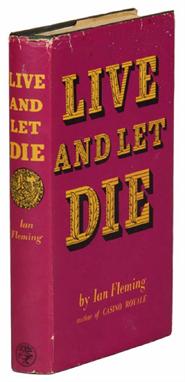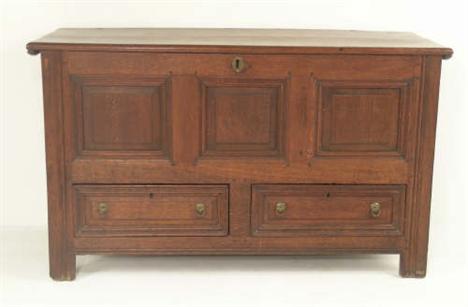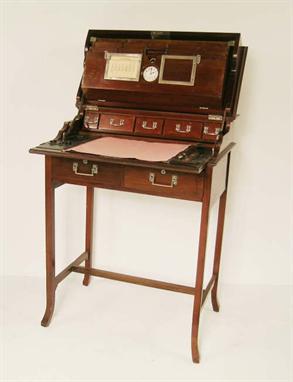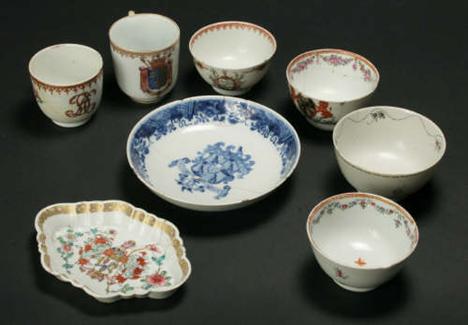Coppard (A.E.). Adam & Eve & Pinch Me, 1st ed., Golden Cockerel Press, 1921, orig. orange boards with printed paper label to spine and upper cover, spine sunned and some dust-soiling, 8vo (550 copies printed), together with a 3rd ed. of the same work, with Jonathan Cape title-page, bound in yellow cloth boards with paper label to spine, plus Clorinda Walks in Heaven, by A.E. Coppard, pub. Golden Cockerel Press, 1922, the author's second book, orig. yellow boards with black linen backstrip and slightly frayed d.j., (1200 copies printed) and three others by Coppard, all published by the Golden Cockerel Press, all 8vo The first title is Coppard's first book and is also the first volume published by the Golden Cockerel Press ('... an unpretentious little volume which nevertheless foreshadows much of its later and riper achievement. It is scupulously unaffected... '). (6)
We found 596772 price guide item(s) matching your search
There are 596772 lots that match your search criteria. Subscribe now to get instant access to the full price guide service.
Click here to subscribe- List
- Grid
-
596772 item(s)/page
Davies (Rhys). The Song of Songs and other Stories, 1st ed., [1927], the author's first book, port. frontis. after William Roberts, orig. printed wrappers, a little soiled and marked, slim 4to (limited edition 812/900) together with Rings on her Fingers, by Rhys Davies, pub. Harold Shaylor, 1930, t.e.g., remainder untrimmed, orig. cloth in cellophane d.j. and slipcase, 8vo (Collectors Edition, no. 72/175 copies, signed by the author, with addn. signed inscription on flyleaf 'H.A. Ovenden, who wastes money buying my disgustingly expensive editions'), plus The Weathered Route, 1927, Rings on her Fingers, 1930, A Pig and a Poke, 1931, Honey and Bread, 1935, all 1st eds., all signed on the flyleaf by the author, all orig. cloth in Art Deco-style black and white d.j.s, 8vo, and others by/about Rhys Davies (20)
Doyle (Arthur Conan). Works, Author's Edition, 12 vols., Smith, Elder, 1903, frontis. to each, first vol. with upper hinge split, t.e.g., remainder rough-trimmed, orig. cloth gilt, spines faded and sl. rubbed at ends, some light soiling, 8vo Limited edition, 230/1000 copies, volume 1 signed by Doyle. (12)
Fleming (Ian). Live and Let Die, 1st ed., 1st issue, Cape, 1954, orig. cloth gilt with medallion vignette to upper cover, in first issue d.j. priced at 10s. 6d. and without cover designer credited, three of four inner flap corners clipped, d.j. rubbed and sl. marked, top edge with occasional chipping, 8vo (1)
An oak dresser, first quarter 19th century, the cavetto cornice over two deflt shelves with boarded back and original blacksmith-made cup hooks over three short frieze drawers fitted with turned wooden handles, above four turned and tapering front supports united by an open pot board on tall bracket feet, 168 cm wide, 192 cm high, 39 cm deep
A Welsh oak clock dresser, first half 19th century, with central 13 (33 cm) white painted clock face with ring of Roman numerals, signed Richard R *****, Welshpool, under a stepped cornice over a short fielded rectangular panelled door revealing a twin weight driven eight-day movement flanked by a two-panel cabinet door to each side over a base of a central twin-panel cabinet door flanked by three short drawers, all fitted with turned wooden handles raised on shaped bracket feet, 158 cm wide, 222 cm high, 55 cm deep (in need of restoration)
A North Wales oak dresser, first quarter 19th century, the ogee-moulded cornice over a lunette-pierced frieze and three open delft shelves with boarded back above a T arrangement of short cock-beaded drawers, all fitted with gilt metal ring handles, flanked by two arched panel single cabinet doors revealing one fixed shelf on a cut out plinth base, 163 cm wide, 203 cm high, 50 cm deep
An oak crossbanded mahogany break-front housekeepers cupboard, first half 19th century, the moulded cornice over three two panel cabinet doors, each revealing two fixed shelves on a base with central single panel cabinet door flanked by four short graduated drawers, fitted with turned ebonised wooden handles to each side, 182 cm wide, 206 cm high, 52 cm deep
An oak crossbanded mahogany North Wales dresser, first quarter 19th century, the cavetto cornice over mahogany wavy frieze above three open shelves (later boarded back) between inverted tapering end upright on a dresser base of three central graduated short drawers, flanked by a three-panel cabinet door to each side, all fitted with brass knob handles on stile end supports, 189 cm wide, 203 cm high, 47 cm deep
A mahogany fall-front writing bureau, first quarter 19th century, the fall revealing an interior of nine pigeon holes over six short drawers above four long graduated cock-beaded drawers, flanked by two lopers, raised on shaped bracket feet, along with an associated bookcase top, the cavetto cornice over two astragal glazed doors revealing three adjustable shelves, 107 cm wide, 212 cm high, 52 cm deep
A mahogany writing desk, first quarter 20th century, the rectangular hinged top with nickle plated Branah lock opening to reveal a fitted interior with stationary rack to the interior of the lid with central time piece in a circular aperture flanked by two rectangular calendar frames over an arrangement of five short drawers with Art Nouveau-style nickle plated handles above a slide-out writing surface with leather pen holders over two short drawers fitted with plated handles on four square tapering legs terminating in splay pointed feet, united by a plain H stretcher, 66 cm wide, 86 cm high, 45 cm deep
A white-and-amber veined marble fire surround, first quarter 20th century, the plain rectangular mantle shelf over a reeded frieze with leaf-carved front corner capitals over a veined marble frieze on two matching columns, grate opening 92 cm wide, 88 cm high, fire surround overall 150 cm wide, 116 cm high (sizes approximate) * Please note VAT is payable on the hammer price of this
A mahogany linen press, first half 19th century, the dentil-moulded cornice over two rectangular single panel doors revealing three sliding shelves over three long graduated cock-beaded drawers, fitted with brass swan-neck handles, raised on shaped bracket feet, 112 cm wide, 205 cm high, 55 cm deep
A Regency mahogany boxwood-strung crossbanded fall front writing bureau, first quarter 19th century, the fall revealing an arrangement of eight pigeon holes, eight short drawers and four long drawers over two short and three long graduated cock beaded drawers fitted with swag moulded swing handles flanked by pull out lopers on splay bracket front feet, 116 cm wide, 108 cm high, 52 cm deep
Hampson (John). Saturday Night at the Greyhound, Hogarth Press, 1931, O Providence, Hogarth Press, 1932, Strip Jack Naked, Heinemann, 1934, Family Curse, Chapman & Hall, 1936, Care Of 'The Grand', Chapman & Hall, 1939, the author's first five books, all 1st eds., all orig. cloth (Family Curse and Care of 'The Grand' in d.j.s and slipcase), 8vo, with others by Hampson, several inscribed by Hampson to H.A. Ovenden John Hampsen Simpson was born in Birmingham in 1901, the fifth of eight children. He was educated at home due to ill health and his lack of formal education left him with a lifelong sense of inferiority. During WWI he worked in a munitions factory but left in 1917 and took a variety of jobs, many of which would later be reflected in his fiction. In 1925 he was engaged by a well-to-do family living in Dorridge near Birmingham, to act as a nurse/companion to their Down's Syndrome son. Hampson's new found security and stability allowed him to begin writing and his first book, Saturday Night at the Greyhound was an immediate success. He made many literary friends including Forrest Reid, Graham Greene and W.H. Auden and became a leading figure in the Birminham group which included Walter Allen, Walter Brierley, Henry Green and Peter Chamberlain. Hampson died in hospital of a heart attack on 26th December 1955. (14)
Huxley (Aldous). Eyeless in Gaza, 1st ed., Chatto, 1936, orig. cloth in chipped and torn d.j with some significant loss along top edge, 8vo, together with Mortal Coils, 1922; Those Barren Leaves, 1925, both 1st eds., pub. Chatto, both orig. cloth with printed label to spine (label to first vol. torn and repaired), rubbed, 8vo, plus The Devils of Loudon, 1st ed., Chatto, 1952, orig. cloth in rubbed and chipped d.j. with loss at head of spine, 8vo, and four others by Huxley (8)
Le Carre (John). Call for the Dead, 1st ed., Gollancz, 1961, orig. cloth in rubbed d.j., some wear to d.j., incl. chipping with loss at foot of spine, a light circular stain to upper cover, a few closed tears and internal tape repairs, etc., 8vo Author's first book, and the debut of George Smiley. (1)
The Owl. A Miscellany, Nos. 1 and 2, pub. Martin Secker, May & October 1919, col. and b&w litho. plts., first vol. in orig. pictorial printed wrappers, second vol. in orig. pictorial boards, a little rubbed in places, large 4to Includes literary contributions from Thomas Hardy, Robert Graves, Siegfried Sassoon, W.H. Davies, John Masefield and others. (2)
Peters (Ellis). One Corpse Too Many, 1979; Dead Man's Ransom, 1984; An Excellent Mystery, 1985; The Raven in the Foregate, 1986; The Rose Rent, 1986, all 1st eds., pub. Macmillan, first vol. is an ex-lib. copy with new endpapers and some markings, all orig. cloth in d.j.s, d.j. to first vol. with a little bit of edge wear, fifth vol. price-clipped, 8vo, together with eight others by Peters (13)
Peters (Ellis, writing as Edith Pargeter). Hortensius, Friend of Nero, 1st ed., Lovat Dickson, 1936, illusts. by John Farleigh, orig. blue cloth in sl. darkened d.j., d.j. chipped with loss at head of spine, 8vo Limited edition 59/125, signed by Edith Pargeter and John Farleigh. Author's first book. (1)
Rankin (Ian). The Flood, 1st paperback ed., Edinburgh, Polygon, 1986, orig. printed wrappers, minor wear, some faint creases to spine, 8vo Author's first book, with approximately 750 paperback and 300 hardback copies issued. This copy apparently presented by the author to his English tutor, inscribed on half-title: "To Faith, from Ian, with all best wishes, 28th Feb 1986". (1)
Rolfe (Frederick, 'Baron Corvo'). Agricultural and Pastoral Prospects of South Africa, by Owen Thomas, 1st ed., Constable, 1904, large folding map at rear, orig. green cloth in first issue state, rubbed, some wear to joints, 2" crease to upper cover, 8vo Woolf B3. Ghostwriten by Corvo, who expanded Owen Thomas's original pamphlet into typically eccentric bookform. This copy is a signed presentation copy from Thomas, inscribed by him on the front free endpaper. (1)
Rylands (George). Poems, 1st ed., printed and published by L. & V. Woolf at the Hogarth Press, 1931, orig. patterned boards with printed label to upper cover, spine sunned, slim 8vo, together with Palmer (Herbert E.), The Armed Muse, 1st ed., Hogarth Press, 1930, presentation copy signed by the author on verso of half-title, orig. boards, spine browned, 8vo, plus Roberts (Michael, ed.), New Country, 1st ed., Hogarth Press, 1933, orig. cloth in rubbed and chipped d.j. with loss to edges, 8vo, and fifteen others pub. by the Hogarth Press, all except two being 1st eds. First item Woolmer 269. An 'early state' copy with the comma after Leonard Woolf's initial. 350 copies printed. This is an unsigned out-of-series copy. (18)
Tolkien (J.R.R.). The Fellowship of the Ring, 1954; The Two Towers, 1954; The Return of the King, 1955, all 1st eds., pub. Allen & Unwin, maps at rear of each, first vol. with owner inscription of [G.E.K.] Braunholtz, second vol. with gift inscription, all orig. cloth, first and second vols. in worn and torn d.j.s with loss, third vol. with remains of d.j., 8vo Ex libris G.E.K. Braunholtz, Professor of Comparative Philology, Oxford 1926-54. (3)
Vonnegut (Kurt). Slaughterhouse-Five, First/Final Draft Screenplay by Stephen Geller, March 25, 1970 & December 21, 1970, 183/133 pp. respec., orig. printed wrappers, spines secured with three brass studs, together with a nine-page synopsis of the film and a two-page copy-document from Eugene G. Dougherty, Vice-President of Motion Picture Association of America Inc., addressed to Miss Arline Conklin of the Law Department, Universal Pictures, California (November 27, 1970) concerning the censor rating of the film, saying that the story appears to be appropriate for an R rating but the excessive use of vulgar language (mostly four letter words, many beginning with 'f') would place the picture in the X category, folio The film was a George Roy Hill-Paul Monash production and the upper cover of the final draft screenplay is marked in felt-tip 'Paul Monash work copy'. (4)
Waugh (Evelyn). Men at Arms, 1952; Officers and Gentleman, 1955; Unconditional Surrender, 1961, all 1st eds., pub. Chapman & Hall, all orig. cloth in d.j.s, some wear to top edge of d.j.s to first and second vols., first vol. sl. chipped with loss at head of spine (spine of first vol. a little sunned also), 8vo, together with five others by Waugh The first three volumes comprise the 'Swords of Honour' trilogy. (8)
White (T.H., writing as "James Aston"). First Lesson, A Novel, 1st ed., Chatto, 1932, minor light spotting to fore-edge, orig. cloth in price-clipped d.j. with pubs. 3/6 'Centaur Library' sticker to spine, a couple of smudges to upper cover, spine a little darkened, 8vo The second of two T.H. White titles published under this pseudonym. (1)
Yeats (W.B.). The Secret Rose, with Illustrations by J.B. Yeats, 1st ed., Lawrence & Bullen, 1897, b&w frontis. and six. plts. (complete), imprint leaf at rear with 110mm x 55mm portion from lower right corner excised (no loss to text), orig. gilt dec. cloth, sl. rubbed at corners and spine ends, 8vo Wade 21. First issue state with 'Lawrence & Bullen' in gilt to spine. (1)
The 1914-18 British War medal and the 1914-19 Victory medal to 2304 Pte.F.T.Smith. Worc. Yeo. the First World War period memorial plaque, detailed Frank Thomas Smith and the memorial scroll, detailed Pte. Frank Thomas Smith, Worcester Hussars, in an ebonised frame, died 23rd April 1916, aged 23, commemorated on the Jerusalem memorial.
James Orrock, RI (1829-1913) ‘Bolton Castle’; ‘Prestonpans’; ‘Loch Goil Head’ Each watercolour over pencil The first signed lower left, titled and dated Sep 1871 lower right The second initialled, titled and dated Sep 1869 lower left The third signed, titled and dated July 1884 lower centre The first 22.5cm x 30.5cm The second 21.5cm x 32cm The third 22.5cm x 37cm (3)
A Worcester (Chamberlains) oval gadrooned Venison deep dish and cover, decorated with stylised puce prunus, pattern no. 1395, 54cm overall, iron-red script and impressed marks, first quarter 19th century Recorded as ‘New Chantilly gadroon, purple Leeds Dinner Service’ See Geoffrey A. Godden, Chamberlain-Worcester Porcelain 1788-1852, page 338
A Chinese export beaker with the arms of Rt Rev. Robert Skinner, Bishop of Bristol; a saucer decorated in underglaze blue with the arms of Laroche with Yeomans in pretence; a famille rose spoon tray with an unidentified crest; a group of four Chinese armorial teabowls and two coffee cans, variously decorated with the arms of Dalyell, a Cavalier General who raised the Scots Greys, and others, most damaged. The first item see Howard, page 229. The second item James Laroche (MP for Bodmin) lived in Over (Gloucestershire) and married Elizabeth Yeomans in 1764 . For Dalyell see Howard, page 629.
A quarto soft-bound diary compiled by Dr. James Williamson (1814-1899), surgeon of the Whaling Ship Lady Jane rendering a unique account of his experiences aboard the vessel during its voyage from the Tyne on the 14th March, 1835 bound for the Davis Straits. Williamson was born at Rochdale, Lancashire, the son of Rev. James Williamson, later pastor of the Baptist Church, North Shields, and studied as a doctor at the University of Edinburgh before joining the Lady Jane, the most successful ship in the National Fleet. In this manuscript he recounts many of the day-to-day experiences he had as surgeon on the ship and also describes the horrors endured by the crew when it was trapped in ice off Greenland from August, 1835 to February, 1836, with twenty seven crew dying from scurvy. In the early 1840's Williamson left university to take up an appointment as medical office for a Benefit Society in connection with the Jarrow Chemical Works on South Tyneside, while at the same time carrying on a private practice at South Shields. After some thirty years he moved to London, dying there in 1899. The Lady Jane, first launched in 1804, was finally crushed by ice during her fiftieth voyage to the arctic in 1849. Literature: The Whaling Trade Of North East England 1750-1850, Tony Barrow, 2001. Sold together with six of Williamson's bleeding tools in red morocco case, a copy of the Highbury Hill Baptist Church Monthly Messenger containing a notice of Williamson's death, and other biographical information. Provenance: A family descendant.
-
596772 item(s)/page






































